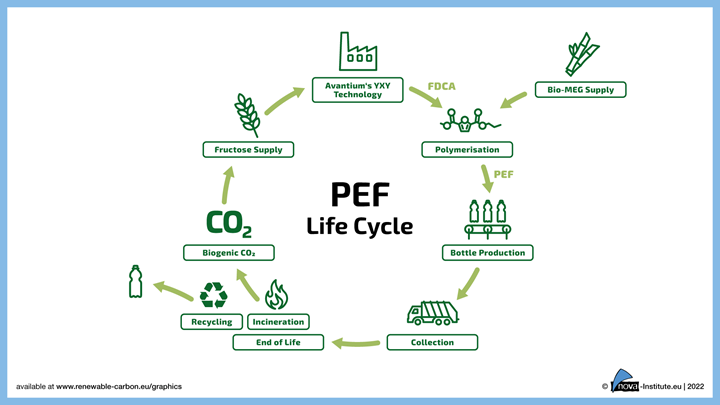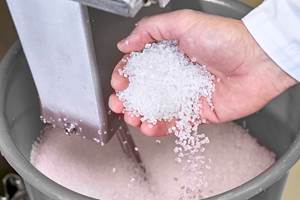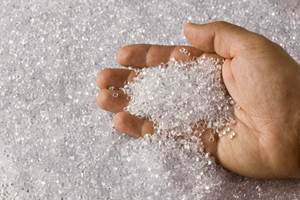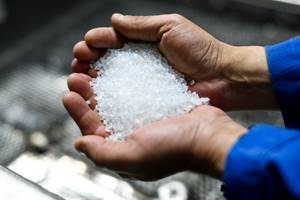Biobased PEF Shows Low CO2 Footprint
Peer-reviewed study by nova-Institute of Avantium’s PEF would result in significant reductions in greenhouse gas emissions.

Within the last couple of years, we have reported on the progress made by Amsterdam-based technology company in renewable chemistry Avantium with its plant -based PEF (polyethylene furanoate). This year alone, we reported on the company’s plans to start-up the world’s first commercial FDCA (2,5-furandicarboxylic acid), the main building block of PEF, in 2024. We also reported that the company has signed offtake agreements with both the global brewery group Carlsburg and the Brazilian brewing company AmBev for the securing of fixed volumes of PEF produced by the new plant.
More recently, the nova-Institute conducted a peer-reviewed Life Cycle Assessment (LCA) of PEF applications within the framework of the European PEFerence project. The study demonstrated that the use of 100 % renewable carbon in PEF instead of fossil carbon in PET for producing 250 ml and 500 ml bottles would result in significant reductions in greenhouse gas (GHG) emissions. Plant-based carbon has a net-neutral impact on the CO2 concentration in the atmosphere. In contrast to this, materials and polymers based on fossil carbon from underground, release additional CO2 into the atmosphere.

Avantium’s YXY technology converts plant-based sugars into a fully recyclable polymer. The new 100 % bio-based polymer, PEF has been shown to have superior performance properties compared to PET. Its main building block FDCA can be produced from sugars (fructose), for example from wheat, corn and sugar beet. FDCA is polymerized with plant-based MEG (mono-ethylene glycol) to make a 100 % plant-based PEF polymer. When fully technologically developed, PEF can also be produced from cellulose and thus from agricultural and forestry waste streams. Avantium’s current process utilizes starch from European wheat.
PEF has enhanced barrier properties compared to PET, it is mechanically and chemically recyclable and can also be recycled within the established PET recycling. PEF has a 53.6 F/12 C higher heat resistance than PET, a 60 % higher modulus and greater strength than PET. This allows the developing of lightweight packaging from PEF with lower resource requirements. Avantium has already implemented this innovative, plant-based packaging material on a pilot scale and recently started the construction of a 11 million lb/yr FDCA flagship plant in Delfzijl (the Netherlands). The nova-Institute’s peer-reviewed full cradle-to-grave LCA conducted according to the ISO standards 14040/44 indicates a significant reduction potential in greenhouse gas emissions and use of fossil resources of PEF compared to PET.
A critical peer-review of the study, including experts of LCA methodology and incumbent packaging solutions, verified that the LCA met the requirements for methodology, data, interpretation, and reporting. The LCA evaluated 16 different impact categories covering all relevant life cycle stages from cradle-to-grave. The comparative analysis showed that PEF bottles would result in significant Institute for Ecology and Innovation 2 reductions in greenhouse gas emissions (-33 %) compared to reference PET bottles. PEF would also lead to 45% lower finite resource consumption of fossil fuels and reduce the pressure on abiotic resources (minerals and metals) by 47 % due to the mechanical properties of PEF enabling light-weighting.

However, PET bottles would outperform PEF-bottles in other impact categories mostly arising from the current feedstock supply. Overall, this represents a benefit because climate change and resource use are among the most relevant environmental impact categories in the current political agenda. They are driving the transition from fossil to renewable carbon. In addition to monolayer PEF bottles, PEF can also be used for multilayer packaging. Multilayer bottles can be an option when the required shelf life cannot be guaranteed by monolayer packaging. PEF offers a good passive barrier for O2 and CO2 and could potentially contribute towards reducing the environmental footprint of packaging solutions by increasing the shelf life of products, enabling a reduction in the weight of packaging, and by improving recyclability.
In this LCA, 250 ml PET/PEF multilayer bottles with 10% of PEF were also assessed and compared to reference PET/PA bottles with a typical 7% of PA (nylon). The analysis showed that significant reductions of around 37% in GHG emissions could be achieved by replacing the PA layer with PEF, mainly attributed to the recyclability of the PET/PEF system over the non-recyclability of the PA-containing system. This replacement would also contribute to a significant reduction of finite resources demand (-37% and -52% of fossil fuels and minerals and metals, respectively).
It is expected that the commercialization and growth of the PEF market will lead to substantial economic, technological, and environmental optimizations covering the full value chain. The impact originating from the plant-based feedstock could also be further reduced by a switch to lignocellulosic feedstocks such as second-generation biomass. This will be tested at Avantium Renewable Polymers in the framework of the BBI-JU PEFerence project, and should confirm that the YXY process can use second-generation biomass when it becomes available at commercial volumes and pricing. An update of the LCA is planned afterwards. A more detailed report on the LCA is available at www.renewable-carbon.eu/publications.
Related Content
Prices Up for All Volume Resins
First quarter was ending up with upward pricing, primarily due to higher feedstock costs and not supply/demand fundamentals.
Read MorePrices Up for PE, PP, PS, Flat for PVC, PET
Trajectory is generally flat-to-down for all commodity resins.
Read MorePrices for PE, PS, PVC, PET Trending Flat; PP to Drop
Despite price increase nominations going into second quarter, it appeared there was potential for generally flat pricing with the exception of a major downward correction for PP.
Read MorePrices for All Volume Resins Head Down at End of 2023
Flat-to-downward trajectory for at least this month.
Read MoreRead Next
See Recyclers Close the Loop on Trade Show Production Scrap at NPE2024
A collaboration between show organizer PLASTICS, recycler CPR and size reduction experts WEIMA and Conair recovered and recycled all production scrap at NPE2024.
Read MoreBeyond Prototypes: 8 Ways the Plastics Industry Is Using 3D Printing
Plastics processors are finding applications for 3D printing around the plant and across the supply chain. Here are 8 examples to look for at NPE2024.
Read MoreFor PLASTICS' CEO Seaholm, NPE to Shine Light on Sustainability Successes
With advocacy, communication and sustainability as three main pillars, Seaholm leads a trade association to NPE that ‘is more active today than we have ever been.’
Read More















